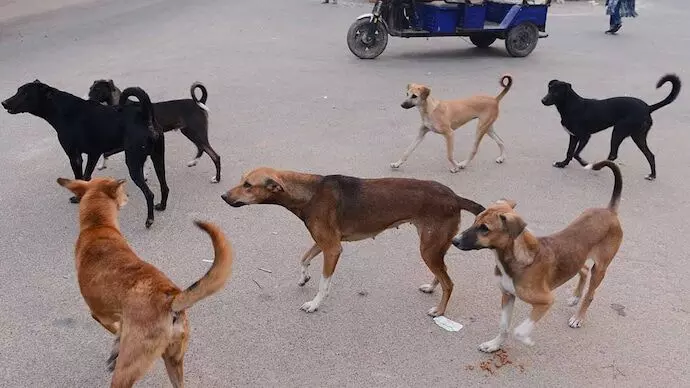Stray dog attacks continue in GHMC; 60,000 unsterilised strays pose threat to pedestrians
In a recent incident, a boy and his mother were injured after a stray dog attacked in Manikonda
By Anoushka Caroline Williams
Representational Image.
Hyderabad: In yet another incident of a stray dog attack in Hyderabad, a boy and his mother were injured in Manikonda Srinivasa Nagar Colony.
The stray dog attacked the boy and continued to do so despite his mother’s attempt to stop the dog from attacking. Bystanders had to step in to rescue them.
Previous incidents highlight severity
This incident follows a series of similar occurrences last year, indicating a pressing issue that demands immediate attention.
In December, a boy suffered serious injuries in Dilsukhnagar due to a stray dog attack. Another incident took place in Nandi Musalaiguda under the jurisdiction of Hyderabad’s Bahadurpura Police Station, where a six-year-old boy was severely injured by a stray dog. Tragically, a 13-year-old girl named Komalla Maheswari lost her life at Gandhi Hospital in Hyderabad after being attacked by stray dogs while doing her school homework.
Need for preventive measures
Despite repeated instances of stray dog attacks in Hyderabad and other districts of Telangana, very less has been done to tackle the issue. The recent incidents underscore the urgency of immediate action to prevent such attacks in the future.
The Greater Hyderabad Municipal Corporation (GHMC) states that nearly 60,000 stray dogs in the city remain unsterilised, posing a challenge for veterinary staff. While 85 per cent of the 3.8 lakh stray dogs in the city have been sterilised, the remaining unsterilised dogs continue to contribute to the problem.
Veterinarians emphasise need for swift measures
Veterinarians stress the importance of swift measures to address the persistent issue of stray dog menace. Dr A Sharma, a veterinary expert, said, “The recent incidents highlight the need for a comprehensive approach, including increased sterilisation efforts and public awareness about responsible pet ownership.”
GHMC’s sterilization efforts and challenges
According to GHMC, 200 dogs are sterilised daily in five animal care centres across five zones of the civic body.
However, challenges arise in catching the remaining unsterilised dogs as they tend to hide upon seeing the GHMC vans. GHMC officials emphasise their commitment to catching and sterilising stray dogs but acknowledge the challenges in managing the large population.
“We are making efforts to catch the remaining dogs at the earliest. However, searching and catching those stray dogs has become a Herculean task as they always hide as soon they see our vans. A total of 60 dog-catching teams have been deployed in three shifts to catch stray dogs,” said a GHMC official from the veterinary wing.
Officials said that it takes a day to sterilize a dog and another five days for post-operative care and releasing them at the same place they were caught. All the dog vans are equipped with a GPS and the dog-catching teams would make note of the location of every dog to leave them post-surgery.
Activists urge for systematic approach
Animal activists place responsibility on GHMC officials for catching and sterilising dogs based on complaints rather than adopting a systematic area-wise approach. Activist A Roy asserted, “A comprehensive, area-wise approach is essential to address the root cause of the issue rather than responding reactively to complaints.”